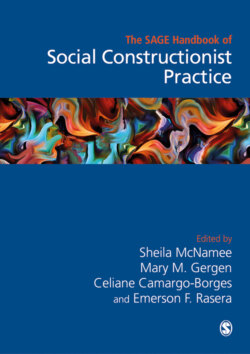Читать книгу The Sage Handbook of Social Constructionist Practice - Группа авторов - Страница 97
На сайте Литреса книга снята с продажи.
What Comes from ‘Research as Daily Practice'?
ОглавлениеThere are numerous outcomes that we have experienced by utilizing the processes of Research As Daily Practice. Completed project descriptions can be found elsewhere (St George et al., 2015b; Wulff et al., 2015a; Wulff et al., 2015b). In addition to new knowledge and practices, the following items highlight what we believe are key qualities.
1 Conducting inquiry in a manner that is respectful of practitioners’ time and contexts. Pragmatic considerations (time, effort, money, material adjustments) of traditional research are too often downplayed. The more that the ‘research’ ideas can be embedded in our practice, the better for the practitioner and the more likely that those initiatives will be taken up.
2 Using research methodologies and processes that are compatible with the practices being examined (for example in our situation we use reflecting team processes or conversations for both our clinical work and our information collection/recording). The process of organizing data could be done in a myriad of ways, from the most technical to the most simple and hands-on. Ideally, we would organize our data/information in ways that mirrored what we did with the organized information (the researching resembles the actions that evolve).
3 Immediate uses of still-evolving knowledge in the practice context. There is no need to wait until the ‘results are in’ using this approach. The development of the information gathering and sense-making that evolve serves as a springboard to try out the ideas along the way. Once begun, Research As Daily Practice continues to regenerate itself – inquiries stimulate new inquiries. Agencies who use this process are effectively understood as ‘learning communities’. Service delivery is melded with learning and growing on the part of the practitioners. In everyday life examples, we engage in trial-and-error processes that continue to refine what we know and what we do as we go along. Similar to the action research processes, we learn by doing and observing the effects.
4 A willingness to adjust inquiry along the way to better understand the issue of interest. The fluidity and responsiveness of methods of inquiry to what we are studying allows for better attention to the complexities of the issues we are trying to study. Just as practices need to be flexible to serve others more directly and effectively, so, too, researching and inquiry must have a plasticity. The curiosities that fueled the initial initiative keep those questions in the forefront – if our chosen methods get in the way of the questions of interest, then our processes are transformed (as opposed to the reverse which often happens). Similar to Point 3 above, we benefit by an ongoing testing of what we know or expect in order to make adjustments. There is no need to get it ‘right’ the first time – we develop strategies through iterations of approximations. This is a process of continuous learning that is well-suited to the changed circumstances of life – a useful outcome or choice at one point will likely not stay that way.
5 This approach to research does not need extra money and the entanglements that come with it.
